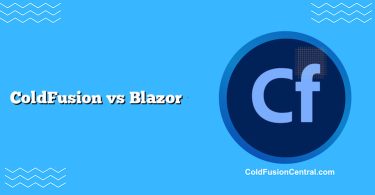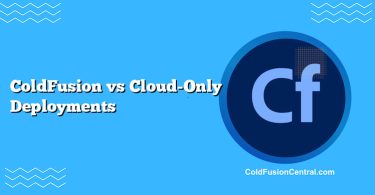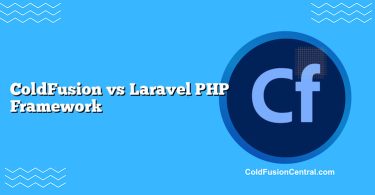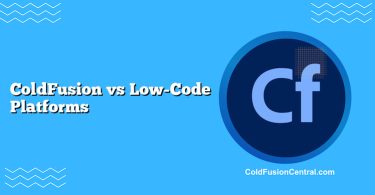Definitions
- Adobe ColdFusion: A commercial CFML application server from Adobe that runs on the JVM. It provides a runtime, admin console, and a rich standard library for building web apps, APIs, scheduled jobs, PDF/reporting workflows, and enterprise integrations.
- CommandBox: A free, cross‑platform CFML CLI and runtime manager from Ortus Solutions. It’s a developer/DevOps toolchain—package manager (ForgeBox), REPL, task runner, and server launcher—that can spin up CFML engines (Adobe ColdFusion or Lucee) on demand for development, testing, and production.
Overview
What you’re actually comparing
At first glance, “ColdFusion vs CommandBox” feels like apples vs oranges. One is an application server; the other is a toolchain. In practice, they are complementary:
- Adobe ColdFusion is the engine/server that executes CFML.
- CommandBox is the CLI that automates and orchestrates CFML engines (including Adobe ColdFusion), dependencies, servers, and CI/CD tasks.
You can use Adobe ColdFusion without CommandBox, but many teams use them together: CommandBox to manage lifecycles and infrastructure, and Adobe ColdFusion as the runtime.
How they fit together
- CommandBox launches lightweight servers (Undertow via Runwar) and can run:
- Lucee (open-source CFML engine)
- Adobe ColdFusion (commercial engine) via WAR/web distribution
- It also provides a module ecosystem (ForgeBox), scripting, and config-as-code to standardize environments across dev, test, and production.
Supported Platforms and Ecosystem
Platforms
-
Adobe ColdFusion
- OS: Windows, Linux, macOS (server versions typically on Windows/Linux)
- Java: Runs on the JVM (bundled or external)
- App server: Based on Apache Tomcat
- Deployment: Installer or WAR; common with IIS/Apache via connectors; popular in VMs and Docker containers
-
CommandBox
- OS: Windows, Linux, macOS
- Java: JVM-based; portable single-binary style
- Servers: Embedded via Undertow (Runwar), with reverse-proxy to CFML engine
- Deployment: Local dev, Docker, ephemeral CI servers, production with reverse proxies (NGINX/Apache) or in containers
Language and syntax notes (CFML)
- CFML dialects:
- Adobe ColdFusion: Adobe CFML
- Lucee: Lucee CFML with minor dialect differences
- Tags vs script: Both engines support tag-based syntax (
) and script-based syntax (CFScript). - Common web features: Routing, ORM (Hibernate in Adobe ColdFusion), caching, sessions, REST/JSON APIs, file I/O, PDF generation (Adobe CF strong here), email, schedulers, gates/queues.
Key Features
Adobe ColdFusion highlights
- Enterprise integrations: Native PDF generation/manipulation, Office document processing, report generation
- Built-in services: REST, WebSocket, scheduler (cfschedule), asynchronous operations
- ORM: Hibernate-based ORM (cfproperty, entity)
- Security features: Secure profile setup, sandbox security, lockdown guides, Security Code Analyzer
- Admin console: Datasource management, mail servers, caching providers, pools
- Commercial support and updates: Vendor-backed patches and hotfixes
CommandBox highlights
- Server management: start/stop multiple servers instantly; pin CF engines (Adobe/Lucee) by exact version (cfengine=adobe@2023, lucee@6)
- Package manager: ForgeBox for modules, libraries, and scaffolding; semantic versioning
- CLI/REPL: Run CFML commands, scripts, tasks; automate with CommandBox tasks
- Config-as-code: .env support, CFConfig for exporting/importing CFAdmin settings
- DevOps tooling: Profiles for development vs production, server.json, integrated testing with TestBox, and CI-friendly workflows
- Containers: Official Docker images and recipes; ideal for ephemeral environments and microservices
Performance
Throughput and startup
- Adobe ColdFusion (Tomcat-based) typically has robust throughput for enterprise workloads. Startup time can be heavier compared to lightweight embedded servers, especially with many datasources, ORM, or complex libraries loaded.
- CommandBox servers often start quickly for Lucee-based instances. When using Adobe ColdFusion via CommandBox, Undertow proxies to the CF engine; startup can be comparable to or slightly more than native Tomcat, depending on configuration.
Factors that matter more than the tool choice
- JVM tuning: Heap size, GC settings, thread pools
- Caching: Query caching, template caching, external caches (Redis/ehcache)
- I/O and integration latency: Database, messaging, external APIs
- Cold start vs warm: Precompiling CFML templates; warming caches/routes
In short, for raw speed, both Adobe CF and Lucee (via CommandBox or traditional deployment) can be tuned to perform well. Your engine choice, caching strategy, and JVM tuning usually trump whether you launched via CommandBox.
Practical performance tips
- Precompile templates during build/release
- Use async operations for slow I/O
- Cache expensive queries and template fragments
- Externalize long-running work to queues or schedulers
- Profile with FusionReactor or YourKit to find hotspots
Scalability and DevOps
Scaling Adobe ColdFusion
- Vertical: Increase CPU/RAM; tune thread pools and datasources
- Horizontal: Multiple CF instances behind a load balancer (IIS/Apache/NGINX/HAProxy)
- Sticky sessions or session storage in Redis/database
- Containerization: Official/third-party Docker images; Kubernetes orchestration
Scaling with CommandBox
- Ephemeral servers: Spin up per-branch or per-commit servers for QA
- Immutable infrastructure: Build once, deploy everywhere with server.json and CFConfig
- Microservices: Launch many small CFML services with pinned engine versions
- Infrastructure as code: Recreate entire stacks consistently in CI/CD
CommandBox shines in DevOps-first workflows where automation, version pinning, and repeatability are critical.
Security
Adobe ColdFusion security features
- Secure profile: Hardens default installation
- Sandbox security: Constrain file system and Java library access
- Lockdown guides and auto-lockdown tooling
- Security Code Analyzer for common vulnerabilities
- Vendor patches: Routine hotfixes and security updates
Best practices: Keep updated, follow lockdown guidance, and review code for SQL injection, XSS, and CSRF. Use parameterized queries and built-in encodeFor* functions.
CommandBox security considerations
- Minimal attack surface: CLI and embedded server not exposed by default
- Config-as-code: Version-controlled CFAdmin settings via CFConfig
- TLS/HTTPS: Terminate at NGINX/Apache/ELB; configure secure headers
- Docker: Use slim images, run as non-root, scan images for vulnerabilities
- Keep CF engines patched: CommandBox simplifies upgrading the underlying engine
CommandBox doesn’t replace secure coding or engine-level patching; it makes updates and secure configuration repeatable.
Cost and Licensing
Adobe ColdFusion
- Licensing: Commercial
- Editions: Standard and Enterprise
- Cost: Enterprise-grade pricing per core/CPU; Developer Edition is free for local dev; trials available
- Support: Vendor SLAs, enterprise support contracts
Check Adobe’s current price list; ballpark budgets often reach thousands per server/core.
CommandBox
- Licensing: Free and open-source
- Cost model: No runtime license fee; optional commercial support from Ortus Solutions
- Value: Reduced Ops overhead via automation, faster onboarding, standardized environments
Lucee as an alternative engine
- Open-source CFML engine; no license fees
- Often used with CommandBox for development and production
- Feature differences vs Adobe CF (e.g., built-in PDF/report features) may influence your decision
Community and Support
Adobe ColdFusion
- Official support: Adobe enterprise support, security bulletins, hotfixes
- Community: Stack Overflow, CFML Slack, Adobe CF portal, conferences (CF Summit)
- Ecosystem: Commercial add-ons, monitoring tools (e.g., FusionReactor), PDF/reporting
CommandBox / Ortus ecosystem
- Community: ForgeBox modules, CFML Slack (#box-products), Ortus community forums
- Documentation: Extensive docs for CommandBox, CFConfig, TestBox, WireBox, ColdBox
- Events/training: Into the Box conference, workshops, professional support from Ortus
Real-World Use Cases
When Adobe ColdFusion is the better anchor
- Enterprise reporting and PDF-heavy workflows
- Compliance: You need official vendor support, predictable SLAs, and certified patches
- Existing CFML monoliths: Mature apps using ORM, scheduled tasks, and CFAdmin-managed services
- Teams that favor commercial support and enterprise-grade stability
Scenario: A financial services firm needs guaranteed support and PDF generation for client statements, with strict patch management. Adobe ColdFusion provides vendor assurances and built-in document services.
When CommandBox-centered workflows shine
- DevOps automation: Spin up identical environments per branch in CI; ephemeral test servers
- Microservices: Many small services with pinned engine versions and lightweight startup
- Containers: Docker/Kubernetes deployments with server.json, CFConfig, and .env files
- Polyglot stacks: CommandBox servers behind NGINX/Traefik with external observability
Scenario: A SaaS startup builds a CFML API microservice architecture. Each service has its own server.json and CFConfig. CI spins up CommandBox servers for tests, and Docker images are deployed to Kubernetes with blue/green rollouts.
Side-by-Side Comparison Table
| Aspect | Adobe ColdFusion (Server/Engine) | CommandBox (CLI/Toolchain) |
|---|---|---|
| Type | Commercial CFML application server | CFML CLI, package manager, and server manager |
| Primary purpose | Run CFML apps with enterprise features | Automate, package, and launch CFML engines (Adobe/Lucee) |
| Performance | Strong enterprise throughput; Tomcat-based | Lightweight servers; performance depends on chosen engine and tuning |
| Scalability | Vertical/horizontal scaling; connectors; containers | Ephemeral servers; easy horizontal scaling, microservices, containers |
| Security | Secure profile, sandbox, lockdown guides, vendor patches | Config-as-code (CFConfig), easy updates; relies on engine security |
| Cost | Licensed, enterprise pricing; Dev Edition free | Free/open-source; optional support from Ortus |
| DevOps fit | Traditional ops; Docker available | Built for CI/CD, IaC, and reproducible environments |
| Best use cases | PDF/reporting, enterprise SLAs, legacy monoliths | Microservices, CI, containers, rapid dev onboarding |
| Pros | Vendor support, rich built-ins, admin console | Automation, version pinning, ForgeBox ecosystem, fast startup |
| Cons | Licensing cost, heavier installs/config | Not an engine itself; depends on Adobe/Lucee; needs reverse proxy in prod |
Pros and Cons
Adobe ColdFusion
Pros
- Vendor-backed support, patches, and SLAs
- Rich built-ins: PDF, Office, image manipulation, scheduler, REST
- Mature admin console and enterprise features
- Strong compatibility with existing CFML applications
Cons
- Licensing costs and budgeting complexity
- Heavier runtime footprint and startup compared to minimal stacks
- Less “cloud-native” out of the box than container-first toolchains
- Some features overlap with modern external services you might already use
CommandBox
Pros
- Free, open-source; excellent DevOps and CI/CD integration
- Spin up Adobe CF or Lucee engines quickly; pin exact versions
- ForgeBox packages, CFConfig, .env, and server.json make environments reproducible
- Ideal for Docker/Kubernetes and ephemeral testing
Cons
- Not an application server itself; you still choose and manage an engine
- Requires ops discipline for reverse proxies, TLS termination, and monitoring
- Enterprise support is via Ortus or community (unless combined with Adobe CF support)
- Feature set focuses on tooling, not on built-in enterprise services like PDF
Decision Factors / Which One Should You Choose?
- Need vendor-backed enterprise support, PDF/reporting, and a traditional app server?
- Favor Adobe ColdFusion as the runtime. Optionally use CommandBox to automate and containerize Adobe CF deployments.
- Need automation, microservices, containers, and frictionless CI/CD?
- Favor CommandBox for orchestration. Choose the engine per service: Adobe CF where enterprise features/support are essential; Lucee for cost-effective, lean services.
- Budget sensitivity:
- CommandBox + Lucee reduces licensing costs. Adobe ColdFusion adds predictable enterprise support and features.
- Migration/modernization:
- Keep Adobe ColdFusion for core systems if needed, but adopt CommandBox to standardize builds and deployments.
- Team skills and workflow:
- If your team invests in IaC, GitOps, and containers, CommandBox aligns perfectly.
- If your team prefers vendor-managed stability and a traditional admin console, Adobe ColdFusion is compelling.
Common hybrid choice: Adobe ColdFusion as the engine for mission-critical apps, orchestrated with CommandBox for consistent, repeatable deployments across environments.
Key Takeaways
- Adobe ColdFusion and CommandBox are complementary: one is a CFML engine/server, the other is a DevOps toolchain to manage engines and environments.
- For enterprise features and official support, use Adobe ColdFusion; for automation, portability, and microservices, use CommandBox.
- You can combine them: CommandBox to orchestrate Adobe ColdFusion for modern CI/CD and containerized deployments.
- Performance depends more on engine choice, tuning, and architecture than on whether the server was launched via CommandBox.
- Costs and governance often drive the engine decision (Adobe CF vs Lucee), while delivery velocity and consistency drive the CommandBox adoption.
FAQ
Is CommandBox an alternative to Adobe ColdFusion?
Not directly. CommandBox is a CLI and server manager that can run Adobe ColdFusion (and Lucee). It’s a complement to the engine rather than a replacement.
Can I run Adobe ColdFusion in production using CommandBox?
Yes. Many teams run Adobe CF behind NGINX/Apache with CommandBox-managed servers, often inside Docker/Kubernetes. Use CFConfig for configuration and follow Adobe/Ortus hardening guides.
How does Lucee compare if I use it with CommandBox?
Lucee is a fast, open-source CFML engine with no licensing fees. It differs in some features vs Adobe CF (notably around PDF/reporting). CommandBox makes using Lucee easy in dev and prod.
What about monitoring and debugging?
Both Adobe CF and Lucee work with tools like FusionReactor for profiling and monitoring. CommandBox integrates smoothly into those setups and can help standardize agent configuration across environments.
Do I need CommandBox if I already use Docker?
It helps. CommandBox provides reproducible server.json/CFConfig-driven images, simplifies engine version pinning, and speeds up local dev and CI. Many teams layer CommandBox inside Docker for maximum consistency.




